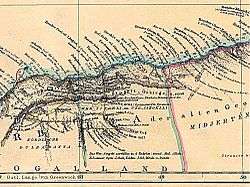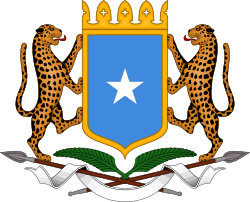Warsangali Sultanate
| Warsangali Sultanate Saldanadda Warsangeli سلطنة الورسنجلي | |||||||
|---|---|---|---|---|---|---|---|
| 1218–1886 | |||||||
| Status | Somali Sultanate | ||||||
| Capital | Las Khorey | ||||||
| Common languages | Somali · Arabic | ||||||
| Religion | Islam | ||||||
| Government | Absolute Monarchy | ||||||
| Sultan | |||||||
• 1298–1311 (first) | Garaad Dhidhin | ||||||
• 1897–1960 (last) | Mohamoud Ali Shire | ||||||
| History | |||||||
• Established | 1218 | ||||||
• Decline | 1886 | ||||||
| |||||||
| Today part of |
| ||||||
The Warsangali Sultanate[1] (Somali: Saldanadda Warsangeli, Arabic: سلطنة الورسنجلي) was a Somali Sultanate ruling house centered in northeastern of Somalia. In 1884, the United Kingdom established the protectorate of British Somaliland through various treaties with the northern Somali sultanates (Dir, Isaaq and Harti including the Warsangali). The Warsangali clan constituted 20,000 of British Somaliland's total population of 640,000 (3.1%).[2]
History
I. M. Lewis, in his book A Pastoral Democracy: A Study of Pastoralism and Politics Among the Northern Somali of the Horn of Africa, refers to the Sultan from the colonial literature as a "man of unusual influence", a "man of mercurial image", and a "man of unusual strength". Several Somali Sultanates existed in Somalia prior to the European imperialism of the 19th century, but the Warsangali Sultanate was the only one with a robust tax-based centralized administration. Lewis writes:
Vestiges of a similar degree of centralized administration on the pattern of a Muslim Sultanate, survive today in the Protectorate among the Warsangali. Prior to 1920, the Garaad had at his command a small standing army with which, with British support, he fought Sayyid Mahamad Abdille Hassan's forces. But Garaad's powers' are dwindling under modern administration.
Northern Somali sultanates

In his paper The 'Mad Mullah' and Northern Somalia, the historian Robert L. Hess touches upon this alliance, writing that "in attempt to break out of Obbian-Mijertein encirclement, the Mullah sought closer alliances with the Warsangali of British Somaliland and Bah Geri of Ethiopia".[3]
The first success in this Anglo-Italian cooperation came in December 1910. In that month, the British Warsangali and the Italian Mijertain peacefully resolved all their outstanding disputes and, convening in Bander Kasim, agreed to act jointly in combating Mohammed Abdullah Hassan and his Dervishes. This accord marked the first real strategic success for the italians and the British in the policy of containing the Mullah.[3]
Somali-British treaties
Between 1884 and 1886, the British government thus signed treaties with the Habr Awal, Habr Toljaala, Habr Gerhajis, Eesa, Gedabursi and Warsangali Somali clans.[4] The tribes agreed (among other things) not to "cede, sell, mortgage, or otherwise give for occupation, save to the British Government, any portion of their territory, and they were placed under British Protection".[4]
Civilization, society and Islam
The Somali scholar Said Ali Nur indicates that regions such as Zeila, Sanaag and Harar became centers of dispersal for the founders of many Muslim communities in the Horn. In fact, the founder of the Darod clan is venerated as a saint by many members of said clan. This sort of veneration is internalized in the customs of all Somalis, and these figures are known as "ancestor saints". Through them, man's appeal to the mercy and blessings of God is strengthened. Although these saints are respected, due to their intermediary role, they themselves are not directly worshipped.
According to historical testimony by the British Lieutenant John Hanning Speke in his journal What led to the Discovery of the Source of the Nile, published some 31 years before the Somali-British treaty of 1886 wherein the English agreed to provide military and logistical support to the Isaaq near Aden in Yemen, the decline in power of the Warsangali Sultanate began thus:
| “ | The Warsangali complained to me sadly of their decline in power since the English had interfered in their fights with the (Isaaq), which took place near Aden about seven years ago, and had deprived them of their vessels for creating a disturbance, which interfered with the ordinary routine of Traffic. They said that on that occasion, they had not only beaten (Isaaq) but had seized their vessels; and that prior to this rupture, they had enjoyed paramount superiority over all the tribes of the Somali; but now they were forbidden to transport Soldiers or make reprisals on the sea, every tribe was on an equality with them." (Chapter II the Voyage-Somali Shore, Garaad Mohamoud Ali Shire). | ” |
Speke also discussed the relative strength of the Sultanate's administration, opining that Garaad Mohamoud Ali was a capable leader:
| “ | Of course no Mortal man was like their Garaad Mohamoud Ali in leading them to war. He was like the English or the French, and in settling disputes, he required no writing office, but sitting on the woolsack. | ” |
Warsangali-Dervish collaboration
I. M. Lewis cites this brief incident in his book, A Modern History of the Somali:
The Warsangali clan within the British protectorate on the eastern coast who under their spirited leader Garaad Mahamud 'Ali Shire had now decided to throw in their lot with the Dervishes and in January 1908, fired on a British dhow as it was landing on their coast. This incident has led to a hostile exchange of letters with the consul at Berbera and it was evident that the Dervishes would soon be on the March again.[5]
In may 1916 the Dervish attacked Las Khorey but were repelled by a British Warship. In september of that year fearing a Dervish invasion, British troops occupied Las Khorey at the insistence of Sultan Mahamud ALi Shire.[6]
See also
- Mohamoud Ali Shire
- Mohammed Abdullah Hassan – religious and nationalist leader
- Yusuf Ali Kenadid – founder of the Sultanate of Hobyo
- Somali aristocratic and court titles
- List of Sunni Muslim dynasties
- Sultanate of Hobyo
- Majeerteen Sultanate
Notes
- ↑ Warsangeli Sultanate
- ↑ Lewis, I. M. (1999). A Pastoral Democracy: A Study of Pastoralism and Politics Among the Northern Somali of the Horn of Africa. James Currey Publishers. ISBN 9780852552803.
- 1 2 Hess, Robert L. "The 'Mad Mullah' and Northern Somalia" (PDF). Journal of African History. 1964: 423. Retrieved 10 February 2018.
- 1 2 Hertslet, Sir E. (2013-05-13). The Map of Africa by Treaty. Routledge. ISBN 1136018549.
- ↑ I. M. Lewis, A modern history of the Somali: nation and state in the Horn of Africa, (James Currey: 2002), p. 74.
- ↑ "King's College London, King's collection : Ismay's summary as Intelligence Officer (1916-1918) of Mohammed Abdullah Hassan".
References
- Lewis. I. M. A Modern History of Somalia: Nation and State in Horn of Africa. Ohio: Ohio University Press, 1960.
- Hess. Robert L. "The 'Mad Mullah' and Northern Somalia". The Journal of African History, vol 5, no. 3 p. 415–433. Cambridge: Ohio Cambridge University Press, 1964.
- Speke. John Hanning. "Sultan/Garaad Mohamoud Ali—Hidden Treasure—Royal Reception—Sultan Tries my Abban". What Led to the Discovery of the Source of the Nile. Edinburgh: Edinburgh William Blackwood and Sons 1864.
- British Empire. Protection treaties with Somaliland tribes. Edinburgh: William Blackwood and sons, 1887.
- Lewis. I. M. Pastoral Democracy: A Study on Pastoralism and Politics among the Northern Somali Clans. Ohio: Ohio University Press, 1958.
- Alinur, Said. "Abyssinian Invasion: Reminder of a Seven Century old Animosity". 17 January 2007. Source
